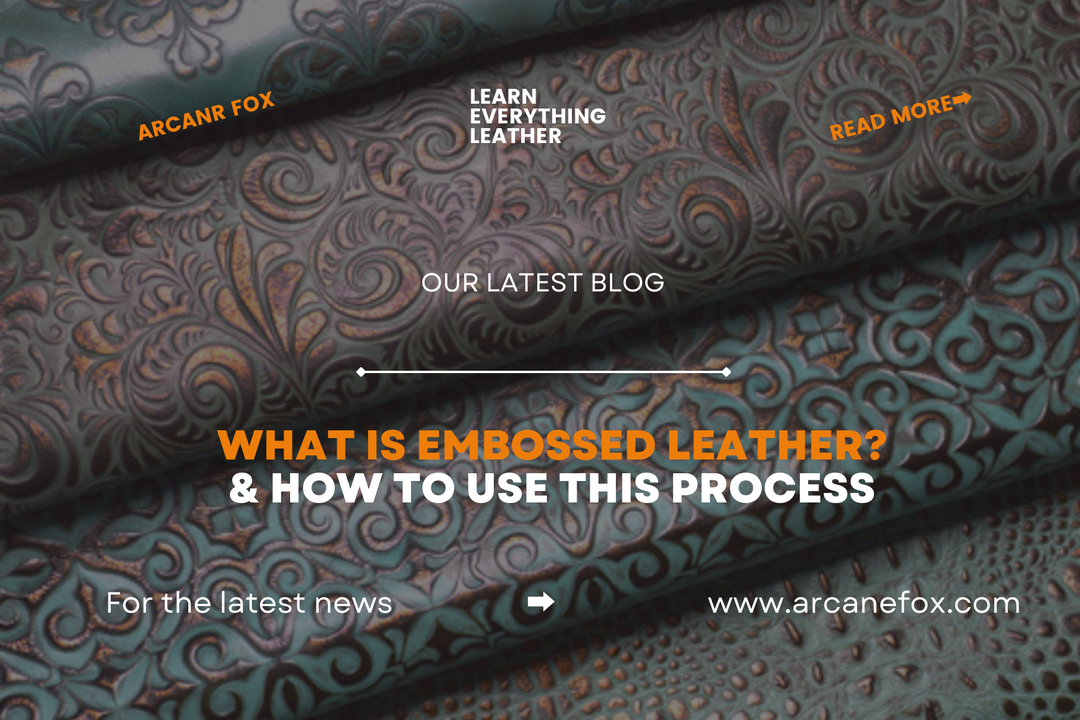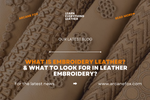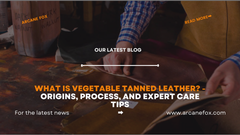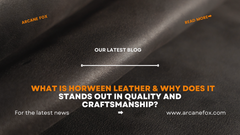What is Embossed Leather? & How to Use This Process

What is Embossed Leather? & How to Use This Process
Have you ever wondered what gives some leather products their intricate, eye-catching patterns? The answer lies in a fascinating process known as leather embossing. Imagine transforming a plain piece of leather into a work of art with designs that range from classic textures to bold, modern motifs. Embossed leather not only elevates the aesthetic appeal but also tells a story of craftsmanship and innovation.
As my leatherworking skills improved, I realized I wanted to give my creations a greater personality. I wanted to add a unique characteristic that identified each piece as mine because I was proud of the items I was crafting. This desire led me to discover leather embossing, a versatile approach to labeling my work.
Using pressure and occasionally heat, the leather embossing technique leaves a picture on the material. The contour of the design is permanently etched into the leather by pressing down embossing stamps. Whether using a stamp and mallet or a press machine, embossing is a technique you can easily try at home.
Leather embossing is an excellent way to personalize a leather product, adding that extra touch of individuality and style. In this post, we'll delve into the world of embossed leather and provide crucial knowledge for embossing leather in a workshop. Whether you’re a fashion enthusiast, a car aficionado, or a home decor lover, embossed leather has a unique charm that’s hard to resist. Let's explore what makes it so special.
1. What is Leather Embossing?

The process of embossing leather is used to decorate leather with designs. Using a mallet or press, the procedure forces imprints into the surface of the leather. The intended design will have been created when the leather is removed since it has sunk in.
Heat can also be used in leather embossing to increase the possibilities. Heat increases contrast because it causes the leather to become darker after being slightly burn. As an alternative, foil can be apply to the design using heat, enhancing the image with a coated metallic sheen.
2. Clearing Up Myths & Misconceptions
Hot foil stamping is sometimes depict as a procedure needing big, expensive machines. Even though these machines are ideal for adding foil embossing, you may do it on a tight budget. Heat activates an adhesive layer on foil, which is how it adheres to the surface below. In light of this, all that is require is a hot stamp.
The application of foil can be done with electric portable branding tools. When stamping, foil can be utilize since the stamps are heat after being link to the machine. Although it will be more difficult to get the ideal temperature, it is less expensive and takes up less room than hot stamping equipment.
3. Reasons You Might Choose To Emboss Leather
Projects can benefit from embossing in a types of ways to provide visual appeal. The most common option is to include a logo. Crafters can certify their leather products by stamping their seal of approval on them using a brand's image. Customers can also employ embossing to fulfill their wishes.
In leathercraft, names, initials, or unique imagery are frequently use to personalize products and increase their worth. To disguise flaws in leather using embossing is an intriguing application. A region can't be use if there are bug bites, scratches, or other blemishes on the surface of the leather.
3.1 Variations or Styles of Leather Embossing
When tanning leather, a large machine that rolls a print onto the surface produces embossing by applying pressure and heat to the leather to produce a crisp, detailed pattern. There are a few solutions available to crafters who want to emboss items at home.
The first is pressure cold stamps. This stamping technique benefits from the flexibility of vegetable-tanned leather. By wetting the surface and applying pressure to the stamp with a mallet or press, the stamp's design will be permanently etch into the leather.
Hot stamps are use in place of cold stamps in a similar embossing technique. In order to press a brass stamp into the leather, certain equipment or instruments must first be heat. More contrast and the capacity to stamp with adherent foil are two advantages of the heat.
4. What Types of Leather Embossing?

4.1 Blind Embossing Leather
In this type of leather embossing, processes are conduct without using color or pigments. Therefore, what you see doesn't appear to be an extra coating or treatment but rather a natural component of the animal's hide.
4.2 Color Embossing Leather
Color embossing is the opposite of blind embossing. Colors and pigments are apply to leather in this type as it is stamp, presse, or subjected to other embossing techniques.
4.3 Gold Embossing Leather
In this specific type of leather embossing, gold leaf is use.
5. Popular Types of Embossed Leather Goods
5.1 Embossed Leather Purse

A popular method in the purse business for giving leather handbags a trendy edge is embossing. By pressing patterns and designs into leather, it is possible to give handbags the appearance and texture of different animals. Using embossed leather, handbags with crocodile, alligator, zebra, cheetah, and even snake prints can appear remarkably lifelike. In addition to geometric and floral patterns, leather embossed purses frequently have floral decorations.
5.2 Embossed Leather Journals
Embossed leather journals are popular among artists, journalists, amateurs, and anybody who enjoys writing. They are well-like for their sturdy construction, protection, and traditional, upscale appearance. Leather-bound journals can be personalize by adding initials, significant dates, and other markings using letters and numbers. Embossed leather journals are available in a types of forms, dimensions, and hues, making them truly unique.
5.3 Crocodile Embossed Leather
Some of the most expensive products, such as handbags, wallets, belts, watch bands, and briefcases, are made from genuine crocodile leather. However, it only accounts for a minor portion of the total output of leather because of its scarcity and high cost. Leather with crocodile embossing is a perfect substitute for expensive clothing to achieve high fashion without spending a fortune. To make leather resemble real reptile skin when use to make products, a pattern resembling crocodile skin can be press into the material.
5.4 Embossed Leather Wallets

Due to its strength and adaptability, leather is one of the most widely use materials for wallet production. Wallets made of embossed leather may have designs pressed into them (or perhaps simply a straightforward branding or logo). These frequently last longer than wallets made of polyester or cotton and come in a variety of styles that are ideal for people who want a more distinctive or customized wallet. The charm of embossed leather wallets may occasionally be enhance by exotic prints like crocodile or ostrich.
5.5 Embossed Leather Belts
Any wardrobe can benefit from the flair and practicality that pattern-stamped leather belts can bring. Although cowboy belts and other "western" clothing are typically associate with embossed leather belts, one need not be a cowboy to wear one. In order to fully display the embossing, tooling is sometimes done to a belt to give it an artistic appeal. This is frequently done when the shirt is tucked in.
5.6 Faux Embossed Leather
The term "faux embossed leather" refers to "leather" that has been emboss over a plastic foundation. It can perform similarly to leather in terms of functionality (albeit typically at a lesser cost), but it won't likely last as long or develop a patina like real leather. The plasticky feel of faux embossed leather, which is typically a giveaway that you're looking at faux embossed leather goods, is prevalent on more affordable wallets and handbags.
6. How To Emboss Leather Step by Step?

- Remove any dust or debris from the leather's surface to prepare it. When embossing vegetable-tanned leather, dampen the surface first.
- The leather should be place on the device or work area. If your embossing procedure involves heat, start the machines so they can get warm up.
- Set the embossing stamp in the desired position. Machines frequently contain grids or spacers to maintain the stamp's square alignment with the leather.
- Holding the stamp firmly at the base, strike the top of the stamp several times with force. When utilizing a machine, the press will be brought down and driven into the leather using buttons or a level.
- Examine the leather condition after removing the embossing stamp. For it to be flawless, it could need a few more hits.
7. How To Get Better at Leather Embossing?
Understanding the type of leather you are working with is crucial if you want to get better at embossing leather. For vegetable-tanned leather with a smooth surface and no texture, embossing is suitable. However, any kind of surface and leather can be use.
Knowing your tools is the next stage towards improvement. The first few times, getting the ideal embossing mark could be challenging since it can be challenging to maintain it aligned with the leather. Stamps are frequently mark with a center point by crafters to aid with alignment.
It is best to practice on scrap leather to determine how much pressure, heat, and time the stamp requires to release cleanly in order to better grasp machines. It will take practice to become better at embossing, as with any aspect of leatherworking. Although the process is simple, embossing scrap leather can aid in enhancing depth, clarity, and spacing control, resulting in more consistent embossing.
8. Our Personal Research on Leather Embossing
The author of this article talks about their own investigation into leather embossing methods, focusing on two key implements: the embossing wheel and acrylic stamp. They weigh the advantages and disadvantages of each instrument to decide which is best for various embossing applications.
The embossing wheel is characterize as a multipurpose tool with a brass circle that spins freely and embossed patterns repeatedly. However, it works best with smooth, dampened vegetable-tanned leather. Although the tool is rapid, it may cause uneven embossing and make it difficult to maintain straight lines. Another design problem mentioned is the absence of a distinct ending mark at the conclusion of the embossing region.
The acrylic stamp, on the other hand, stands out since it can be customize using 3D printing, making it a reasonable option for artisans. Despite not having a 3D printer, the author tested a sizable acrylic stamp on wet, vegetable-tanned leather. They mention the lack of handles and uniform pressure needed for consistent outcomes with acrylic stamps. Although the method seemed to work rather well, they had high hopes for the depth and cleanliness of the final image.
Further web research finds that acrylic embossing stamps may need extra sanding to remove flaws, and that they are less durable than conventional brass stamps, necessitating replacement over time.
9. Chemicals For Embossing Leather
Chemicals are use to improve leather results. The goal of using such chemicals is to stamp or clamp images and designs that are crystal clear and apparent. These compounds also contain other water-based solubles such as acrylic, silicon, and silicon dioxide.
10. Embossed Leather VS Printed Leather

In simple terms, printed leather is a finishing method for leather. This method allows the leather to have amazing patterns, colors, textures, and other effects. The distinction between printed leather and embossed leather is now brought up.
Embossed leather is a subcategory of printed leather, which is essentially a macro category. In addition, all of the patterns you see on leather are print, as opposed to embossed patterns that resemble reptile skin.
11. Engraving Leather Vs. Embossing Leather
Leather can be engrave using the same tools that are use to emboss it. But to comprehend the distinction between embossing and engraving leather, you must know that when you emboss leather, the leather is squeez, and when you engrave leather, you cut and scrape the leather to remove some of it. Both techniques are intend to improve the leather's quality and give it a unique look.
12. Conclusion
Embossed leather hides are taken from a variety of animals, mainly reptiles and exotic animals. The process of embossing leather occurs during the last stages of leather manufacture. We therefore hope that you now fully comprehend what embossed leather is, as well as its many requirements and procedures. It is best not to confuse this leather with printed or engraved leather; this leather has numerous advantages. As a final illustration, you may have noticed wallet embossing with lizard skin and other patterns.
Learn more about leather here Leather 101 - The Ultimate Guide to Different Types of Leather
Related Topics
What is Aniline Leather? Types of Aniline, Characteristics, And More
What is Semi-Aniline Leather? History, Characteristics, And More
What is Burnished Leather? & Why Should It’s Be Your Top Choice
What is Antique Leather? & Why it is So Popular
What is Bicast Leather? Myths, Facts, and Benefits
What is Embroidery Leather? & What to Look for In Leather Embroidery?
What is Faux Leather? It’s Quality & Durability Against Other Leather!
What is Nappa Leather? Quality, Characteristics, and Maintenance
What is Nubuck Leather? & How is it Different From Suede Leather
What is Oil or Pull-Up Leather? It’s Durability, Characteristics, and Maintenance
What is Patent Leather? & How to Maintain It’s Quality and Shining
What is Pigmented Leather? How is it Made, It's uses and characteristics





